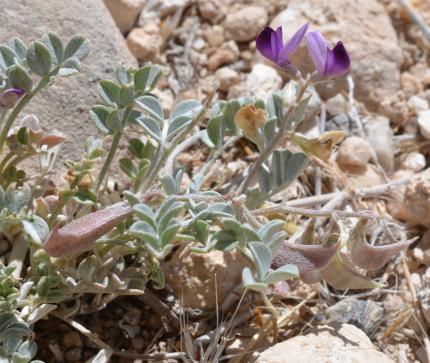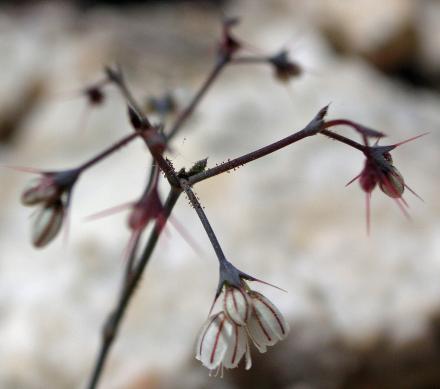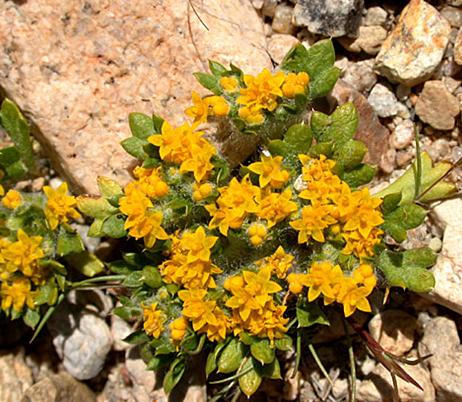WHAT IS AN HERBARIUM?
An herbarium is a collection of dried and pressed plant specimens, which are mounted on archival quality herbarium paper. A good specimen will contain enough material to properly identify the plant, and will include stems, leaves, flowers and/or fruits, and roots if it is an annual plant. Each specimen has a label with location and habitat information about where the specimen was collected (city, state, county, country, township, range, street intersections, GPS coordinates, etc.), in what type of soil it was found, with what other plants it was growing, the slope aspect, proximity to water, etc. The collection date and collector's name also appear on the label, and there is often a collection number. The scientific name and plant family are also included on the label, as well as the name of the person who identified the specimen.
Why have a herbarium?
- To help identify and learn the plants of a region.
- To learn distributions and habitat requirements of different species.
- To have a historical record documenting past distributions and diversity in order to study migration patterns and evolutionary trends, and also for conservation studies.
- For taxonomic studies; allows observation of variation within and between taxa, and provides information for construction of taxonomic keys.
- Provides locality data to find specific plants for study, collect seeds, and monitor populations.
- Provides documentation and accountability; can verify results of surveys or studies with voucher specimens.
- Provides material for molecular analyses to determine relationships between taxa and variability within taxa.
History of the A. Louise Baartz Memorial Herbarium at VVC:
A. Louise Baartz was a former biology professor at Victor Valley College. During her early years of teaching she taught mainly botany, and she wished to have an herbarium collection for teaching purposes. She began an herbarium collection under the supervision of Dr. Wilbur Mayhew of the University of California at Riverside. In 1973 she registered the Victor Valley College herbarium collection, then with only around 300 specimens, with the California Department of Agriculture. Baartz became involved teaching anatomy, and did not continue to collect specimens. She passed away in the late 1990s. The herbarium collection was revived in 1995-1996, when the VVC Biology Department moved into the new science building. Pam MacKay, who was hired to teach botany in the early 1990s, suggested that a storeroom in the new building be converted to an herbarium. The department agreed to purchase herbarium cabinets, a drying oven, plant presses, and herbarium supplies, and MacKay began collecting. An informal collaboration was established with the Andrew C. Sanders, curator of the herbarium at the University of California at Riverside. The collection now contains approximately 7,000 specimens from the Mojave Desert, southern California, the southeastern Sierra Nevada, and southeastern Arizona. Approximately 2,000 of the specimens are fully accessioned, databased, and available on the UC Berkeley California Consortium of Herbaria (CCH) website (see link below), thanks to the efforts of VVC Herbarium volunteer/assistant curator, Tim Thomas. Thomas and other volunteers, including Claudia Marsh, a retired VVC Biology Department Lab Technician, are working on accessioning the remainder of the collection. This not only involves gluing and labeling of specimens, but also identifying previously unidentified collections, databasing field collection information, and geo-referencing some of the older collections with latitude and longitude data that are sometimes lacking or deficient; GPS units are used to get lat/long data for the more recent collections. All of the collection data, including location, are provided to the CCH. These data are used to construct collection location maps that will pop up on the Jepson eFlora website whenever a query is made about a particular species. The map shows geographic locations for all specimens of a particular taxon that are housed in all CCH-affiliated herbaria; it therefore represents a collective effort to map the distribution of a species.
How to access the Victor Valley College Herbarium:
The VVC Herbarium does not have regular open hours. You can access the herbarium by contacting the curator, Pam MacKay at: pamela.mackay@vvc.edu, or 760-245-4271, ext. 2467, to set up an appointment.
How to find information about plant specimens housed at the Victor Valley College Herbarium:
Since the VVC Herbarium is a member of the California Consortium of Herbaria, information about all of our accessioned specimens is available on the CCH website (different than the Jepson eFlora website): LINK TO UC BERKELEY JEPSON HERBARIUM CONSORTIUM
Links to information on some of the rare plants of the Mojave Desert
| Description | Photograph |
|---|---|
|
(Opuntia basilaris var. brachyclada) (Photo by Pam MacKay) |
Image

|
|
(Cymopteris deserticola) (Photo by Pam MacKay) |
Image

|
|
(Astragalus albens) (Photo by Pam MacKay) |
Image

|
|
(Penstemon albomarginata) (Photo by Pam MacKay) |
Image

|
|
(Mimulus mohavensis) (Photo by Pam MacKay) |
Image

|
|
(Phacelia parishii) (Photo by Tim Thomas) |
Image

|
|
Mojave Thistle(Cirsium mohavensis) (Photo by Pam MacKay) |
Image

|
|
(Puccinellia parishii) (Photo by Tim Thomas) |
Image

|
|
(Photo by Tim Thomas) |
Image

|
|
(Erigeron parishii) (Photo by Pam MacKay) |
Image

|
|
(Oxytheca parishii var. goodmaniana) (Photo by Pam MacKay) |
Image

|
|
(Eriogonum ovalifolium var. vineum) (Photo by Pam MacKay) |
Image

|
|
(Plagiobothrys parishii) (Photo by Pam MacKay) |
Image

|
|
Little San Bernardino Mountains Linanthus (Linanthus maculatus) (Photo by Pam MacKay) |
Image

|
|
(Canbya candida) (Photo by Tim Thomas) |
Image

|
|
(Eriophyllum mohavense) (Photo by Tim Thomas) |
Image

|
Links to other herbaria and plant groups:



